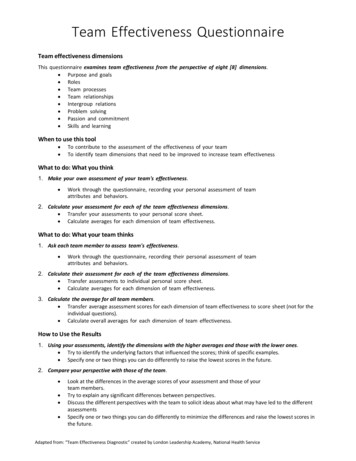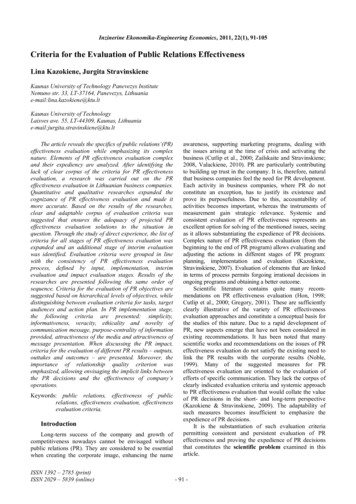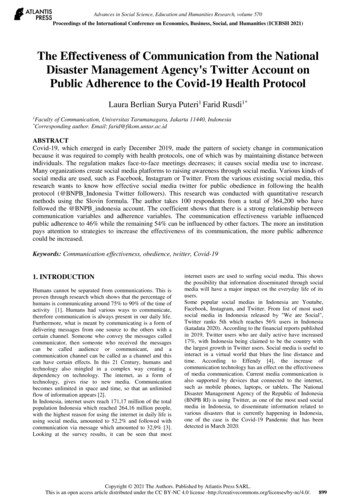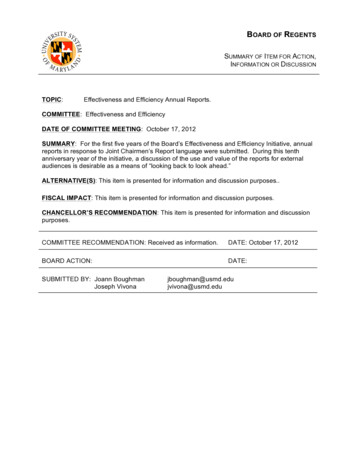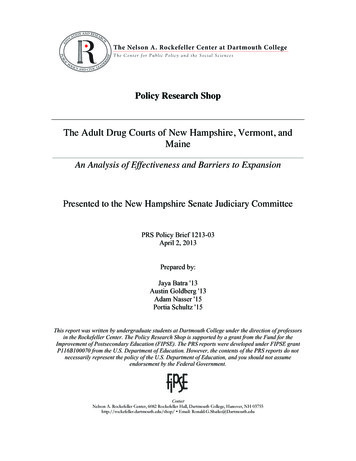
Transcription
Policy Research ShopThe Adult Drug Courts of New Hampshire, Vermont, andMaineAn Analysis of Effectiveness and Barriers to ExpansionPresented to the New Hampshire Senate Judiciary CommitteePRS Policy Brief 1213-03April 2, 2013Prepared by:Jaya Batra '13Austin Goldberg '13Adam Nasser '15Portia Schultz '15This report was written by undergraduate students at Dartmouth College under the direction of professorsin the Rockefeller Center. The Policy Research Shop is supported by a grant from the Fund for theImprovement of Postsecondary Education (FIPSE). The PRS reports were developed under FIPSE grantP116B100070 from the U.S. Department of Education. However, the contents of the PRS reports do notnecessarily represent the policy of the U.S. Department of Education, and you should not assumeendorsement by the Federal Government.ContactNelson A. Rockefeller Center, 6082 Rockefeller Hall, Dartmouth College, Hanover, NH 03755http://rockefeller.dartmouth.edu/shop/ Email: Ronald.G.Shaiko@Dartmouth.edu
TABLE OF CONTENTSEXECUTIVE SUMMARY11. INTRODUCTION12. DRUG COURTS – OVERVIEW12.1 WHAT IS A DRUG COURT?2.2 ELIGIBILITY123. CRITERIA FOR EVALUATION34. DRUG COURTS IN NEW HAMPSHIRE44.1 STRAFFORD COUNTY4.1.1 Recidivism Rates4.1.2 Cost-Effectiveness4.1.3 Race, Gender, and Age4.1.4 Social Benefits4.2 GRAFTON COUNTY4.3 ROCKINGHAM COUNTY5. DRUG COURTS IN MAINE5.1 ESTABLISHMENT5.2 SOURCES OF FUNDING5.3 OUTCOME FINDINGS5.4 PARTICIPANT STATISTICS5.5 PENOBSCOT COUNTY445566677789106. DRUG COURTS IN VERMONT116.1 CHITTENDEN COUNTY6.2 RUTLAND COUNTY11117. COST-BENEFIT ANALYSIS148. KEY TAKEAWAYS159. KEYS TO SUCCESS1710. BARRIERS TO EXPANSION18CONCLUSION19APPENDIX I21APPENDIX II21REFERENCES22
EXECUTIVE SUMMARYIn this report, we analyze the effectiveness of drug courts in New Hampshire, Vermont,and Maine. In order to measure effectiveness, we use four criteria: recidivism rates; costeffectiveness; impact across race, gender, and age; and social consequences. We find that,for the most part, drug courts promote positive community trends, reduce recidivismrates, and are generally a less expensive alternative to prisons.We also identify several best practices for drug courts, which include clear criteria fortermination, effective use of sanctions and incentives, ongoing judicial interaction,targeted programs for specific demographics, and expeditious referral time. The mostsignificant impediment to the expansion of drug courts into new counties is cost; countiesthat desire drug courts must individually seek out the necessary resources. Other barriersinclude a lack of necessary support from community officials, the perception of drugcourts as being lax on crime, and political opposition.1. INTRODUCTIONThe first drug court was established in Miami-Dade County, Florida in 1989 in responseto a rapid increase in drug use and the resultant overcrowding of prisons. Today, there aremore than 2,600 drug courts recognized by the National Association of Drug CourtProfessionals (NADCP). Of the ten counties in New Hampshire, three have NADCPapproved drug courts (Rockingham, Strafford, and Grafton), two are in the process ofdeveloping drug courts (Cheshire and Hillsborough), and five counties do not have drugcourts (Belknap, Carroll, Coos, Merrimack, and Sullivan). Of the fourteen counties inVermont, three have drug courts (Rutland, Chittenden, and Bennington), and of thesixteen counties in Maine, five had drug courts in 2012 (Washington, Androscoggin,Cumberland, York, and Hancock). In this report, we compare the effectiveness of thesedrug courts, highlight best practices, and outline some of the barriers preventing theexpansion of drug courts to more counties.2. DRUG COURTS: OVERVIEW2.1 What is a drug court?To be officially recognized by the NADCP, a drug court must meet the ten criteriaoutlined by federal Bureau of Justice Assistance (BJA), a component of the Office ofJustice Programs, within the United States Department of Justice. These criteria can befound in Appendix II and are briefly discussed below.First, drug courts must adhere to a treatment and rehabilitation program, which is dividedinto three phases. The first includes detoxifications and an initial treatment assessment.1
The second is an intensive treatment phase that includes individual and group counseling.Finally, participants undergo a transition phase that emphasizes social reintegration,employment, and housing opportunities.1 The program generally lasts between 12 and 24months and is followed by one year of probation.2 Upon successful completion of theprogram and probation, a drug court participant is exempt from his or her prison sentenceand the felony is expunged from his or her criminal record.Another key criterion requires that participants undergo random testing for alcohol andother drugs. The BJA describes these tests as, “central to the drug court’s ability tomonitor participant compliance.”3 Not only does testing help monitor participant progressin overcoming addiction, it also provides drug courts and drug court stakeholders withmore data with which to evaluate individual programs.Making drug courts a data-driven endeavor ensures that participants are receiving the besttreatment possible. According to the BJA, “fundamental to the effective operation of drugcourts are coordinated management, monitoring, and evaluation systems. The goals of theprogram should be described concretely and in measurable terms to provideaccountability to funding agencies and policymakers.”4Finally, drug courts must strive to meet the diverse needs of their clients. Participantsmay be struggling with mental illnesses, medical problems, HIV and other sexuallytransmitted diseases, homelessness, educational deficits, unemployment, spouse andfamily troubles (including domestic violence), and the long-term effects of physical andsexual abuse, in addition to alcohol and other drug addictions.5 Drug courts work withother organizations in the community to meet the specific needs of their participants.Generally, drug courts across the nation have lower recidivism rates than prisons and areless expensive. According to a Government Accountability Office (GAO) report on 32drug court programs across the U.S., “the percentages of drug court program participantsre-arrested were lower than for comparison group members by 6 to 26 percentage points.Drug court participants who completed their program had re-arrest rates 12 to 58percentage points below those of the comparison group.” In terms of drug court costscompared to incarceration, the report also found, “the net benefit ranged from positive 47,852 to negative 7,108 per participant."62.2 EligibilityIn order to qualify for admission to most drug courts, candidates must meet five criteria:they must have an extensive history of drug use, the crime they committed must be anonviolent one, they must plead guilty to their offense (although there are some pre-pleadrug courts), they must live in the county the drug court is located in, and they must havetransportation to and from the drug court.7 The defense counsel then refers candidatesthat meet these criteria to the county drug court coordinator. From there, the candidate2
must receive unanimous approval from the drug court team. The drug court team consistsof representatives from various sectors of the criminal justice system in each county. Theteam meets once per week to discuss the progress of each participant.The goals of drug courts are three-fold: recovery, savings, and social benefits. First, drugcourts seek to help addicts overcome their addictions and to ensure that they do notrecidivate back into the criminal justice system. Second, by allowing participants to livein their homes instead of in prisons and by reducing recidivism rates, drug courts aim tosave money. Finally, drug courts seek to create social benefits, such as reducing crime inthe community and reuniting families. The effectiveness of a drug court in achievingthese goals can be evaluated based on the criteria outlined below.3. CRITERIA FOR EVALUATIONDrawn from a variety of evaluations and performance reviews, such as the BJA's“Defining Drug Courts: The Key Components” and the New Hampshire Center forPublic Policy Studies’ series of Performance Evaluations of Strafford County’s DrugTreatment Court, the following four factors have emerged as useful measures of a drugcourt’s effectiveness: (1) Recidivism rates, (2) Cost-effectiveness, (3) Impact acrossgender, race, and age, and (4) Social consequences. Given the relatively small number ofdrug court participants in these states to date, the ability to make generalizations aboutdrug courts nationally is somewhat limited. Recidivism rates: A primary purpose of drug courts is to help clientsovercome drug addictions and avoid repetition of drug-related crimes. Thesuccess of a drug court in achieving these goals can be gauged to a certainextent by the recidivism rate: the rate at which offenders are re-arrested.Comparing the recidivism rate of drug court graduates to comparableoffenders who are sentenced to traditional methods of incarceration is auseful tool for assessing the impact of drug courts on deterring futurecrime. Analyzing the percentages of individuals that successfully graduatefrom drug courts also offers insight into clients’ tendencies to recidivate orengage in drug use while still in the treatment program. Cost-effectiveness: Drug courts also aim to reduce costs by providing amore rehabilitative alternative to traditional incarceration and by reducingthe social costs associated with drug-related recidivism. Comparing theday-to-day costs of holding individual offenders in correctional facilitiesas opposed to drug courts yields insight into the cost-effectiveness of drugcourts. Given the startup costs of drug courts and the small population sizeof these programs, it is also relevant to consider how long it takes for adrug court to cover its startup and upkeep expenses. Impact across gender, race, and age: Because drug courts seek toestablish proportional sentences and equitable treatment, it is relevant to3
consider the impact that they have on different genders, races, and agegroups. Comparing these groups on graduation rates and other statisticalmeasures should reveal whether or not drug treatment programs affectparticipants with certain demographic characteristics differently. Social Consequences: Drug courts may also engender a variety of socialconsequences that are less easily quantified. Examples include the effectsof drug courts on participants’ families, employment opportunities, andthe like.One of the factors that limits our ability to evaluate these criteria is the relatively smallsample size of drug court participants. For example, New Hampshire only has three drugcourts that meet the BJA’s ten criteria, and one of them was started at the end of 2010.Further, only about 150 people in total have graduated from these courts. This limitedsample size restricts our ability to compare statistics like recidivism rates and costsavings across drug courts.Another limitation is that some studies measure certain statistics differently from the wayother studies measure the same statistic. For example, some studies calculate recidivismby analyzing how many drug court participants are rearrested, while others other considerthe number of graduates rearrested. Some studies also use reconviction as a measure ofrecidivism rather than re-arrest. To the extent possible, this report will attempt to specifythe definition of recidivism used in each invocation.4. DRUG COURTS IN NEW HAMPSHIRE4.1 Strafford CountyIn 2003, almost 14 percent of all arrests in Strafford County were for drug-relatedoffenses.8 In response, the Strafford County Superior Court and the CountyCommissioners obtained a grant from the U.S. Department of Justice to start an adultdrug court program, which became operational in January 2006. Over the last six years,the drug court has maintained an average of 47 offenders enrolled in the program at onetime and has successfully graduated 100 participants.9 Offenders who complete the 12month program go through three phases of targeted treatment that afford them increasinglevels of autonomy, culminating with graduation. Following a year of probation,graduates can petition the court to expunge their charges. In order to evaluate Strafford'sdrug court according to the criteria of this report, data was drawn largely from the NewHampshire Center of Public Policy Studies’ performance evaluations. The comparativelylarger amount of data available on Stafford’s drug court allowed for more extensiveanalysis than possible for some other drug courts.4
4.1.1 Recidivism RatesOf Strafford's 100 graduates, the vast majority have not recidivated. Only ten graduateshave committed a new felony or a misdemeanor level offense since exiting the program.10During their time in drug court, 52 percent of participants tested positive for drug use atleast once and 46 percent were terminated from the program (conversely, 54 percentgraduated).11 However, only nine of the offenders terminated (less than 10 percent)committed a new offense during the program. On the whole, the vast majority ofparticipants did not recidivate during the program and the vast majority of graduates havenot recidivated since. Compared to the national recidivism rate of 33 percent, Strafford'sdrug court has made significant strides in reducing repetition of drug offenses byoffenders within its purview.124.1.2 Cost-EffectivenessStrafford’s drug court also seems to be a cost-effective alternative to incarceration. Thecost of supervising an individual in the Strafford County drug court is 9 per day, whilethe cost of incarcerating an individual in the Strafford House of Corrections is 84 perday.13 Furthermore, judges would still be paid the same salaries irrespective of theexistence of drug courts, possibly causing personnel costs for drug courts to beoverestimated. Most importantly, the Strafford drug court helps curb one of the morecostly phenomena in the criminal justice system: recidivism. With a post-graduationrecidivism rate of ten percent, the Strafford drug court has undoubtedly preempted many 84 per day stays in County Corrections.4.1.3 Race, Gender, and AgeSome trends have emerged regarding the effectiveness of the Strafford drug court acrossgenders and age groups. The Strafford drug court typically maintains a 60/40 male tofemale ratio, which may be because women often opt for alternatives that would placeless strain on their time with family.14 In the first year of the Strafford drug court’soperation, female participants appeared to be struggling due to a lack of gender-specifictreatment groups.15 In response, the court began offering female-only treatment groups ona weekly basis. Grafton County Commissioner Michael Cryans attributed the uniquechallenges that women face in drug courts to caring for children or dealing with thetrauma of past abuse. Despite these barriers, women in the program averaged threepositive drug tests in six months, as opposed to five for men (although women were morelikely to test positive earlier). The younger 50 percent of clients (under age 28) alsoproved to be 12 percent more likely to test positive than the older 50 percent. Youngerclients who had positive tests averaged five positive results in a six-month period and hadtheir first positive result around the 60-day mark. Older clients averaged three positivetests, with the first occurring on average at the 74-day mark.16 Given that 93 percent of5
program participants are white, we do not have enough data to draw conclusions aboutwhether or not the Strafford County drug court is more effective for certain races.17On the whole, males, first-time offenders, clients entering with a drug charge, the olderhalf of participants, and those more adherent to treatment had the highest graduationrates. The highest graduation rate (71 percent) was found among older, first-time drugoffenders. These statistics suggest that women and younger participants continue towarrant special attention from the Strafford drug court team.4.1.4 Social BenefitsBy reducing recidivism and helping clients overcome drug abuse, the Strafford drug courthas provided benefits to the community. As an ancillary benefit, the court also seems tobe successfully encouraging participants to secure and retain employment. Asparticipants move from Phase I to Phase II to Phase III, the percentage of clientssanctioned for failure to obtain employment moves from 19 percent to five percent tozero percent. Between the first and second years of the court’s operation, the percentageof participants rewarded for employment-related activities (typically with applause, giftcards, or candy) increased from 16 percent to 30 percent.184.2 Grafton CountyWith the help of a 20,000 grant from the U.S. Department of Justice, the GraftonCounty drug court was established in 2007. Since 2007, 27 participants have graduated.19The Grafton County drug court has a lower recidivism rate for drug crimes (between 9and 10 percent) than the national average (33 percent).20 In terms of cost, Grafton spends 50,000 per year on its 20 current participants.21 This means that the average participantcosts Grafton 2,500, in comparison to the national average of 9,000 to 12,000. Interms of social benefits, Commissioner Cryans stated in a recent interview, “drug courtsare really saving lives, especially for the young. It gives them a second chance and anopportunity to not let their addiction kill them.”224.3 Rockingham CountyEstablished in 2010 with a 350,000 grant awarded by the U.S. Department of Justice,the Rockingham County adult drug court is the newest of the three New Hampshire drugcourts. It was created to allow non-violent offenders with a history of drug addiction andmental health problems the opportunity to participate in a 12 to 18 month drug treatmentprogram and avoid incarceration.23 Rockingham County Superior Court Judge TinaNadeau directs the program with a planning and operations team, which includesrepresentatives from law enforcement, the county attorney’s office, local treatmentproviders, and other stakeholders.24An advisory committee of community leaders has alsobeen created to guide the drug court team and to provide community outreach.256
Because Rockingham's drug court has only been operating for a year, the sample size ofparticipants is too small to draw conclusions about the court's effectiveness.5. DRUG COURTS IN MAINE5.1 EstablishmentMaine’s first six adult drug treatment courts (ADTC) were established in August 2000and began accepting participants in April 2001. These courts were located in WashingtonCounty, Penobscot County, Androscoggin County, Cumberland County, and YorkCounty. Oxford County’s drug court was discontinued in May 2004 due to underenrollment, and an additional ADTC was created in Hancock County in July 2008.Penobscot County's adult drug treatment court closed in November of 2012, primarilydue to the high recidivism rates of program participants.Since the inception of drug courts in Maine twelve years ago, 1,435 men and womenhave participated in the programs. As of December 31, 2012, there were 150 activeparticipants statewide.26 Drug courts in Maine use a formalized treatment curriculumcalled the Differential Substance Abuse Treatment (DSAT) program, and funding for thespecialized treatment offered comes through the Office of Substance Abuse and MentalHealth Services (SAMHS).27 Maine’s ADTCs are administered by drug court teams ineach county, in cooperation with Adult Community Corrections of the Department ofCorrections, as well as legal and law enforcement partners.28 Information on Maine’sADTCs is centralized through the DTxC database, a web-based data managementinformation system for all of Maine’s drug treatment courts.29 Most of the data presentedbelow on recidivism rates, cost-savings, and court effectiveness have been culled fromannual reports presented by the Maine Administrative Office of the Courts to thelegislature's Joint Standing Committee on the Judiciary.5.2 Sources of fundingThe Office of Substance Abuse, a division of the Maine Department of Health andHuman Services, provides the majority of funding for Maine's drug courts. The programwas implemented over a decade ago with money from the Fund for a Healthy Maineorganization, which was funded by the state’s share of a settlement with the tobaccoindustry.30 When the funding source for Maine’s drug courts shifted to the General Funda few years ago, the amount of money available was reduced. As a result, the drug courtprogram for juveniles was eliminated. Maine’s Judicial Branch has also been therecipient of four BJA grants. The majority of these grants were for enhancing informationsystems, outcome evaluation, and case management services. However, three of thesegrants expired at the end of 2012, and the remaining enhancement grant to WashingtonCounty will end on July 1, 2012.317
5.3 Outcome FindingsBecause Maine’s drug court system is relatively centralized, it is more conducive tostatewide analysis than a county-by-county analysis. Participants in Maine’s drug courtprograms generally enter with very serious substance abuse problems. In the Universityof Southern Maine’s 2006 assessment of Maine’s ADTCs, 81 percent of participantsacross the five counties received scores in the moderate to severe range on theComputerized Screening Assessment (CSA).32 In order to monitor participants as theycomplete the DSAT curriculum, participants generally receive one unscheduled homevisit per month, with some variance across counties. Of the 1,435 program participants,51 percent have graduated, which is higher than the national average of 48 percent. It isimportant to keep in mind what graduation rates can and cannot reveal about drug courts.Although a significantly higher graduation rate than other localities is generally a positiveindicator, Maine drug court program director Harwell Dowling has pointed out that somecourts terminate participants more quickly than others, which may simply reflect morecareful monitoring. A high graduation rate could mean that the drug court is not closelymonitoring progress (which would likely be indicated by the co-occurrence of a highrecidivism rate).According to the Report to the Joint Standing Committee delivered on January 14, 2013,participants in Maine’s adult drug treatment courts are rearrested at significantly lowerrates than are traditionally incarcerated offenders. Recidivism rates one year afterdischarge have historically been 17 percent for drug court participants -- in other words,17 percent of all drug courts participants are reconvicted within one year of leaving thedrug court system -- as compared to 33 percent for traditionally incarcerated offenders.33The Maine Judiciary Branch estimates that for every one dollar spent on adult drug courtsin Maine, 3.30 in savings to the state’s criminal justice system are generated fromreduced recidivism and costs associated with incarceration. This adds up to a projectedsavings in corrections costs of 819,490 from the inception of drug courts in 2001through 2011.34 The drug court system may also generate long-term cost savings in theform of drug-free births: since 2001, there have been at least 60 drug-free births to drugcourt participants in Maine. The estimated total lifetime health care costs associated witha child prenatally exposed to drugs and alcohol ranges from 750,000 to 1.4 million.35Within the first eighteen years of life alone, the cost per child generally approaches orexceeds 1,000,000.36 In 2006, five years after the program was established, theUniversity of Southern Maine estimated that Maine’s drug courts had already produced anet savings of 11,345,726. Their estimate was based on annualized cost comparisonsbetween 269 adult offenders placed in the adult drug court program against thecomparison group of 269 offenders who were traditionally incarcerated.378
Table 1: Cost-Savings Estimate for Maine's Adult Drug Treatment Court ProgramSource: University of Southern Maine, Department of Sociology5.4 Participant StatisticsMost individuals who enroll in Maine’s drug courts are single white men. In 2006, 95percent of participants were white, 64 percent were male, and 58 percent were single.38The demographic makeup of the program generally reflects larger state trends: 95.4percent of Maine residents are white, and 48.9 percent are male.39 It is notable that thescores of men in DSAT pre-post battery assessment were more likely to improve acrossthe board then those of women, which were “more varied and situationally specific.”40When necessary for the purpose of behavioral management, the most commonly usedsanction in Maine’s drug courts is incarceration (used in 38 percent of cases), which isoverwhelmingly used in the case of drug use or new criminal conduct (75 percent).41Less serious infractions such as missing a scheduled appointment generally incurconsequences such as community service (34 percent) or written assignments (22percent). The most frequently utilized incentive is advancement to the next phase (56percent of cases)Aside from the mandatory aspects of the DSAT curriculum, program participants areoffered a variety of ancillary services. As of 2006, 57 percent of participants availedthemselves of at least one of these services, including: batterer’s intervention programs;crisis intervention; and mental health, residential, healthcare, employment, educations,and transportation services. However, since the majority of participants in Maine drugcourts are already employed at the time of their admission (77 percent, with the exceptionof Washington County), the benefits of Maine’s ancillary employment services are not aspronounced as in some other states.9
5.5 Penobscot CountyThe drug court in Penobscot county closed in November 2012, due to performance issuesand funding constraints.42 The 2006 report by the University of Southern Maine foundthat the Penobscot drug court ranked second to last in the state for successful outcomes(York County was last). At this time, the recidivism rate in Penobscot County was 28.6percent, compared to the 25.7 percent of defendants who were sentenced to prison or jailterms.43 In addition to high recidivism rates, other factors cited by Guy Cousins of theOffice of Substance Abuse for the termination of Penobscot’s drug court included thehigher than average turnover of a treatment provider and the availability and support ofother community programs and governmental resources in the county. According toCousins, Penobscot and York counties were given suggestions on how to improve theiroutcomes. York implemented them and its outcome results improved; Penobscot did notimplement the suggestions and its outcomes continued to lag.Due to the closure of Penobscot’s drug court, defendants in the county have been giventhe opportunity to attend drug court in neighboring Hancock County (provided that thedistrict attorneys from both counties approve and defendants have reliable means oftransportation). To date, three individuals have taken advantage of this opportunity.Approximately 118, 600 previously used for substance abuse treatment and casemanager salary has now been reallocated from Penobscot to the Co-occurring DisordersCourt in Augusta, which was previously funded with federal grant money that is nolonger available.446. DRUG COURTS IN VERMONTIn 2007, Act 128 authorized the creation of pilot adult drug courts in Chittenden, Rutland,Washington, and Bennington counties. Several months later, Bennington's drug court wasreplaced by an integrated domestic violence docket, leaving Vermont with three NADCPapproved drug courts. As of 2011, 439 Vermont residents have enrolled in a drug court.Approximately half of participants and graduates are women, compared to 25 to 27percent nationally.45 The most data is available on the drug courts of Chittenden andRutland counties, which will be the focus of analysis.The drug court process is relatively consistent across all three Vermont drug courts. Afterpleading guilty, the defense counsel may refer defendants for non-violent crimes to drugcourt. The drug court team for the county then uses consensus decision-making to eitherapprove or reject the participant. The drug court team includes the judge, the publicdefender, the state attorney, and treatment professionals (which includes clinicians andcase managers). Case managers closely monitor the progress of each participant andpresent the participant's progress to the judge and drug court team once per week. Someteams may also have a probation or parole officer from the Department of Corrections.10
Once enrolled in drug court, participants must complete three phases. In the first phase,participants undergo random drug testing three times per week. Given that several faileddrug tests are expected for participants in the first phase, a failed drug test in this phaseleads to a treatment-based sanction, which could include daily drug testing or counselingsessions. In the second and third phases, participants are randomly tested twice per weekand once per week, respectively. In these phases, sanctions for failing a drug test mayinclude several nights in jail. Sustained sobriety may be rewarded with a round ofapplause from the drug court team or a gift card. Although the program was designed tobe completed in nine months, the average Vermont drug court participant takesapproximately 18 months to graduate.46Drug court participants in Vermont tend to have similar demographic characteristics.Vermont drug courts average about 24 participants at any one time, who have an averagegraduation rate of approximately 46 percent.47 The average participant is white and in hisor her mid-twenties. Drug court par
recidivate back into the criminal justice system. Second, by allowing participants to live in their homes instead of in prisons and by reducing recidivism rates, drug courts aim to save money. Finally, drug courts seek to create social benefits, such as reducing crime in the community and reuniting families.




